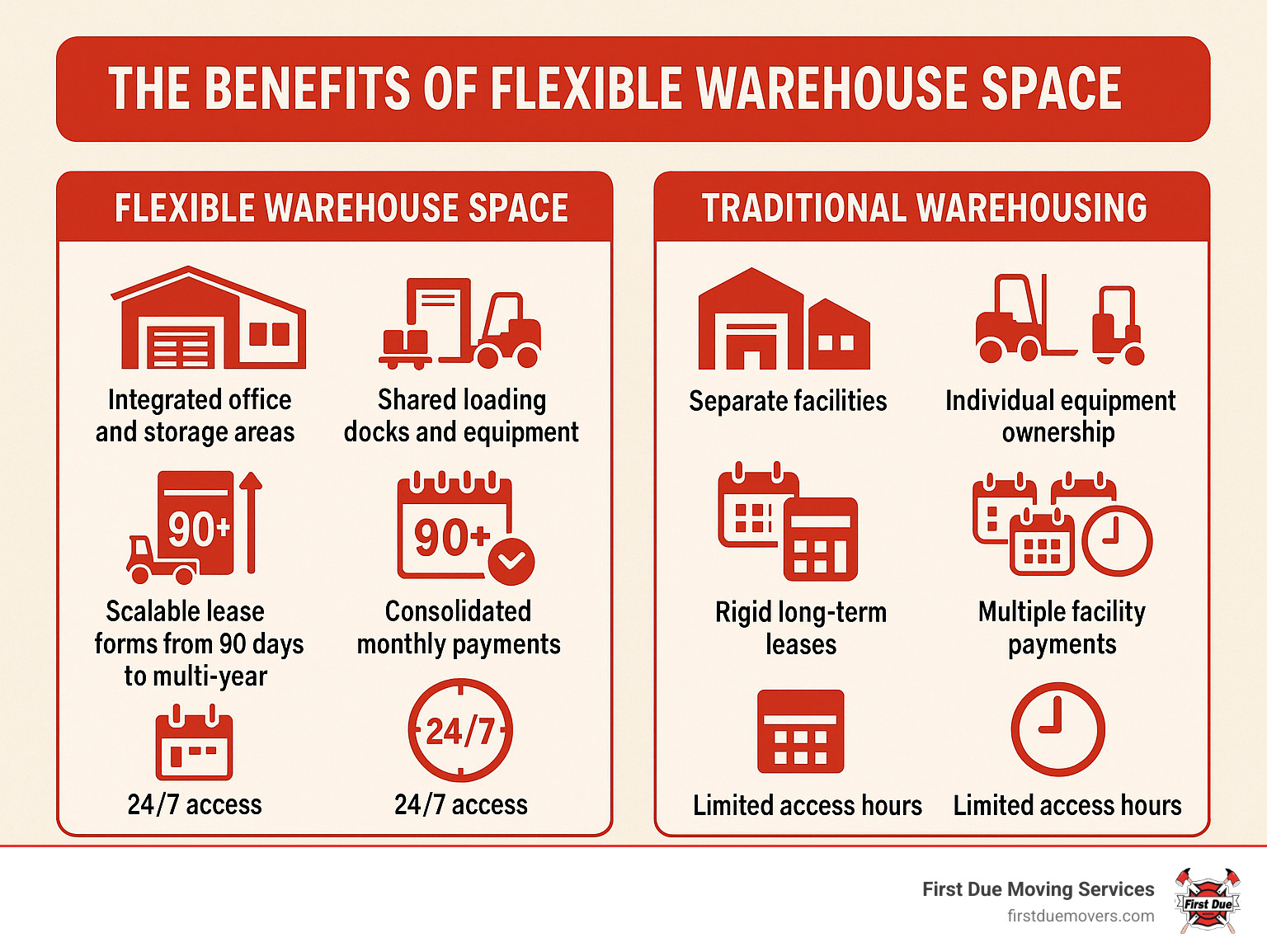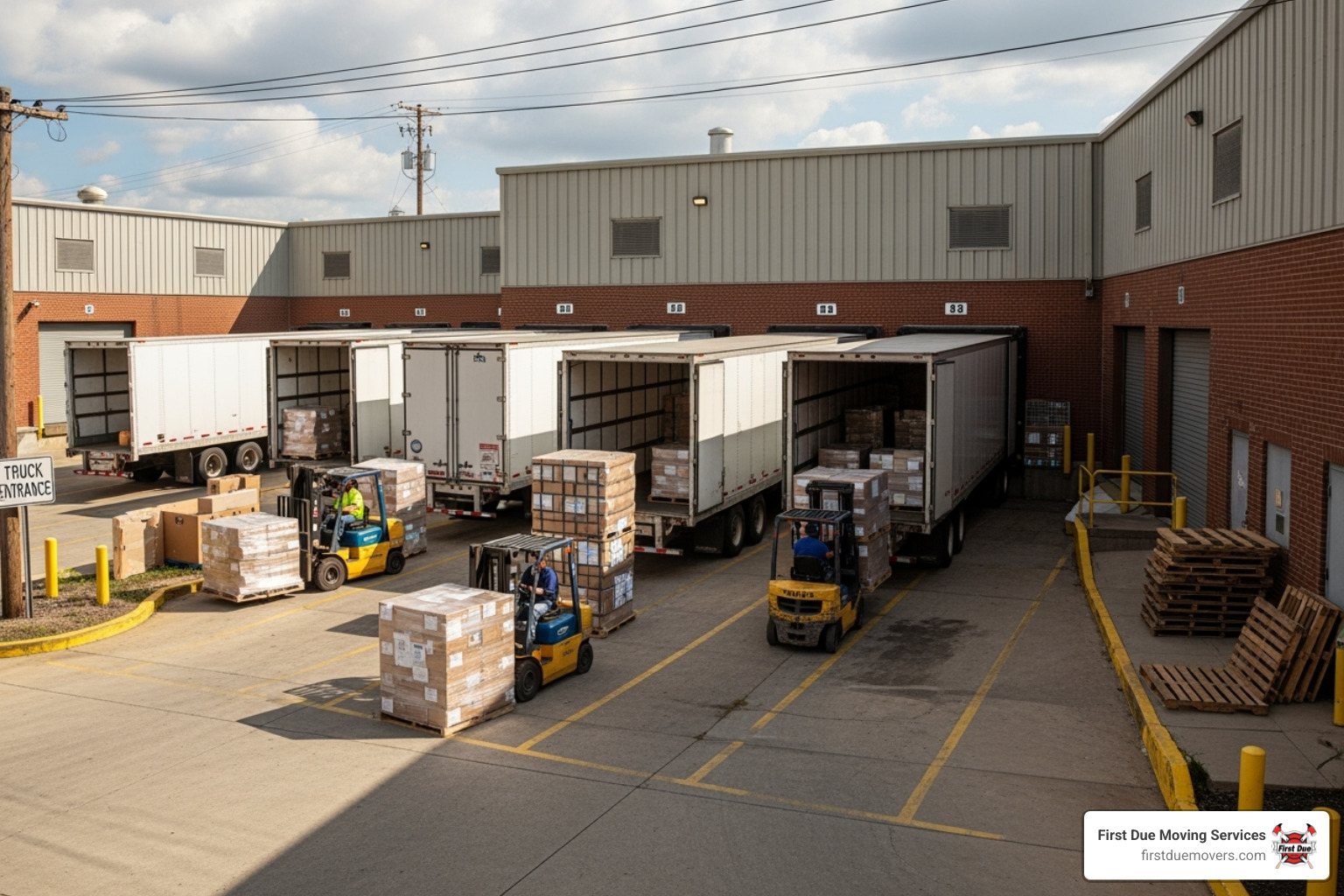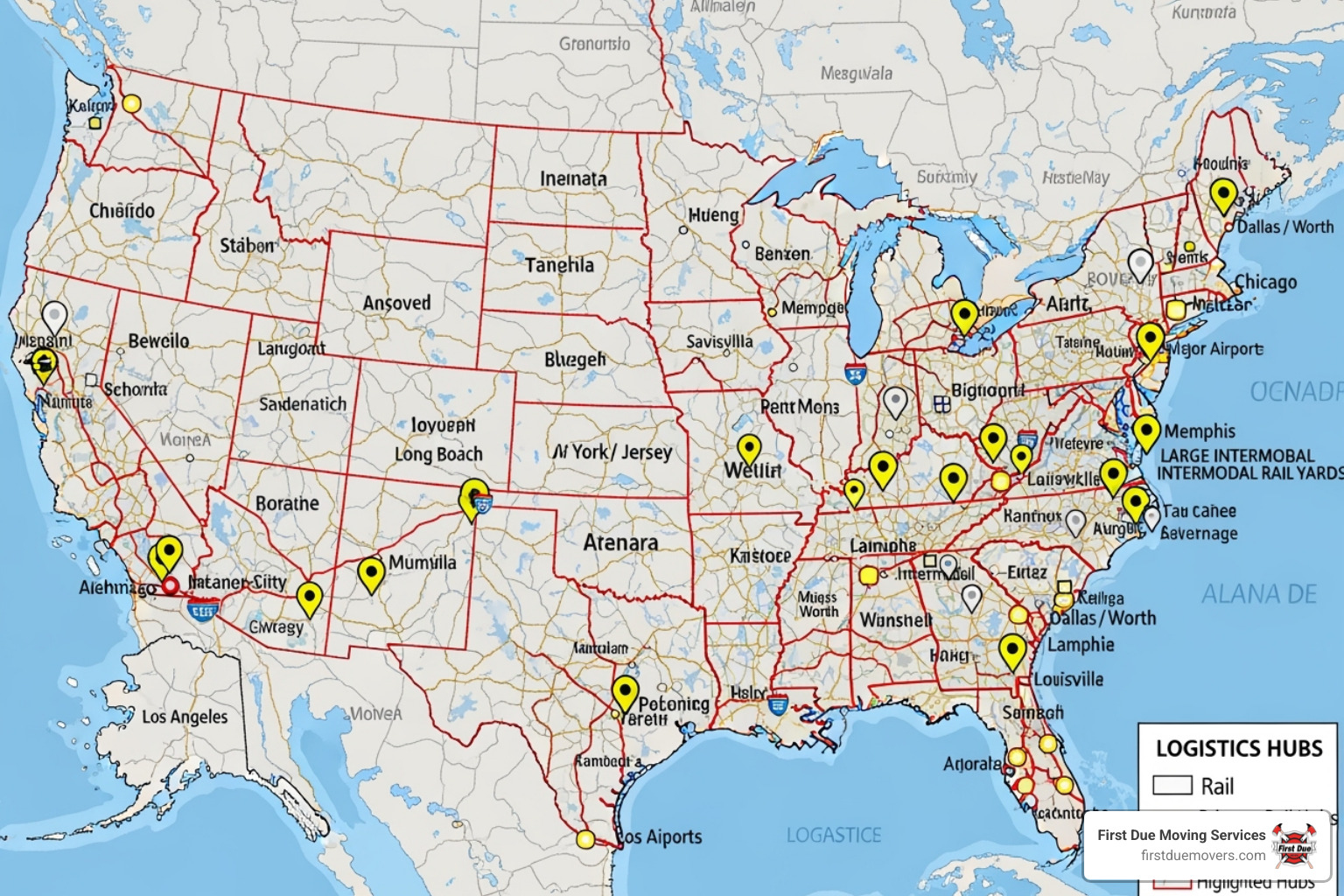Flexible Warehouse Space: Unlock Agility 2025
Why Flexible Warehouse Space is Revolutionizing Modern Business
Flexible warehouse space is changing how businesses approach storage, operations, and growth. Instead of being locked into rigid, long-term warehouse leases, companies can now access adaptable spaces that combine storage, office areas, and operational facilities under one roof.
Key Benefits of Flexible Warehouse Space:
- Scalability: Expand or downsize based on demand without relocating
- Cost Efficiency: One monthly payment covers utilities, amenities, and space
- Operational Integration: Combine storage, office, and shipping in one location
- Short-Term Flexibility: Lease terms as short as 90 days vs. traditional multi-year contracts
- Shared Resources: Access loading docks, forklifts, and equipment without ownership
The demand for adaptable business solutions has skyrocketed. The amount of space occupied by distribution centers and warehouses has increased by a staggering 86.2% since the turn of the millennium. This growth reflects not just expanding e-commerce but also the need for more agile, responsive business models.
Traditional warehousing often forces small and medium businesses into unsuitable arrangements. They’re either stuck with expensive long-term leases for spaces too large, or they settle for basic storage units that can’t support real business operations. Flexible warehouse space bridges this gap.
For busy business owners juggling multiple priorities, flex space eliminates the stress of managing separate office and storage facilities. It consolidates operations, improves team communication, and provides the professional environment needed to serve customers effectively.

What is Flexible Warehouse Space?
Picture walking into a space that feels like the perfect blend of a professional office and an efficient warehouse. That’s exactly what flexible warehouse space delivers – a smart solution that adapts to your business needs rather than forcing you to adapt to rigid space constraints.
Unlike traditional warehouses that serve one main purpose, flexible warehouse space is designed as a hybrid environment. You might have your inventory stored on one side while your team handles customer calls from a built-in office area just steps away. This multifunctional approach means you’re not juggling multiple locations or trying to run a business from cramped storage units.
The beauty of flex space lies in its adaptability. Your seasonal business might need extra storage space in November but more office area in January for planning. With flexible warehouse solutions, these changes don’t require moving trucks or breaking leases. The space grows and shifts with your business rhythm.
What makes this concept truly powerful is its scalability. Whether you’re a startup testing your first product line or an established business expanding into new markets, flexible warehouse space offers on-demand solutions that make sense. You can start small and expand without the headache of relocating your entire operation.
For businesses looking to streamline their operations, these spaces provide comprehensive logistics solutions that bring everything under one roof. For broader context on how these spaces fit within supply chains, see Warehouse and Third-party logistics.
How Flex Space Differs from Traditional Warehousing
The difference between flexible warehouse space and traditional warehousing is like comparing a smartphone to an old landline – both make calls, but one does so much more.
Traditional warehouses typically lock you into long-term commitments spanning five to ten years. They’re designed for single purposes, usually just storage or distribution, with little consideration for integrated office needs. If your business grows or changes direction, you’re often stuck paying for space you don’t need or scrambling to find additional facilities.
Flexible warehouse space flips this model completely. Lease terms can be as short as 90 days, giving you the freedom to adjust as your business evolves. The space utilization is dynamic – you can reconfigure layouts or adjust your square footage without major disruptions.
The upfront requirements tell the whole story. Traditional spaces often demand significant capital investments, separate utility setups, and costly build-outs. Flex spaces typically require just a straightforward monthly payment that covers most utilities and amenities. This transforms warehousing from a single-use commitment into a multi-use solution that supports your entire operation.
| Feature | Traditional Warehouse Space | Flexible Warehouse Space |
|---|---|---|
| Lease Terms | Long-term (5-10+ years), rigid commitments | Short-term (3 months to 3 years), highly adaptable |
| Space Usage | Single-purpose (storage, manufacturing), limited office | Multi-purpose (storage, office, operations), integrated |
| Scalability | Difficult and costly to expand or downsize | Easy to scale up or down, often without relocation |
The Evolution from Storage Unit to a Complete Business Hub
Many businesses start their journey with a simple storage unit – a basic solution for overflow inventory or seasonal items. While storage units serve their purpose, they’re hardly the foundation for professional business operations. Try hosting a client meeting or managing your customer service team from a storage facility, and you’ll quickly understand the limitations.
Flexible warehouse space represents a major leap forward, changing beyond storage into a complete business ecosystem. These spaces support integrated operations where your warehouse team can communicate instantly with your sales staff, where customer questions get answered by people who can actually see the inventory, and where your entire operation flows smoothly.
This evolution creates a truly professional environment that gives small businesses the same operational advantages that large corporations have enjoyed for years. It’s about small business empowerment – providing the tools and space needed to compete effectively without the massive overhead.
The change is remarkable. Instead of driving between your storage unit, your home office, and various meeting locations, everything happens in one cohesive space. Your team can streamline business operations by having immediate access to inventory, shipping facilities, and collaborative workspace all under one roof.
This integrated approach doesn’t just save time – it fundamentally changes how your business operates, making you more responsive, more professional, and more efficient in everything you do.
The Core Benefits of Embracing Flexibility
When you’re running a business, every decision matters – especially when it comes to where and how you operate. Flexible warehouse space isn’t just another real estate option; it’s a game-changer that can transform how your business runs day-to-day.

Think about the last time you had to coordinate between your office team and warehouse staff. Maybe your sales person needed to check inventory levels, or customer service had to track down a specific order. In a traditional setup, this might involve phone calls, driving across town, or waiting hours for updates. With flexible warehouse space, these interactions happen naturally because everyone’s working under the same roof.
This kind of operational efficiency isn’t just convenient – it’s powerful. When your administrative team can walk over to check inventory in person, when your shipping crew can instantly communicate with customer service about urgent orders, and when your entire operation flows seamlessly together, you’re not just saving time. You’re creating a work environment where problems get solved faster and opportunities don’t slip through the cracks.
The business growth support that comes from this setup is remarkable. Your space grows with you instead of holding you back. During busy seasons, you can expand. When things slow down, you can scale back. Most importantly, you can focus on what you do best instead of wrestling with real estate headaches.
There’s something deeply satisfying about having everything consolidated in one place. One location to manage, one set of keys, one address for deliveries. It’s the kind of simplicity that busy business owners dream about – and with flexible warehouse solutions, it’s entirely achievable.
Gaining Financial Agility and Reducing Overhead
Let’s talk about money – specifically, how flexible warehouse space can keep more of it in your pocket where it belongs.
Traditional warehouse leases can feel like financial quicksand. You’re looking at massive upfront costs, long-term commitments that stretch years into the future, and a maze of separate bills for everything from electricity to internet. It’s enough to make any business owner’s head spin.
Flexible warehouse space flips this model on its head with lower start-up requirements that actually make sense. Instead of writing checks for build-outs, deposits, and utility connections before you’ve even moved in, you can often be operational within days. The space comes ready to work, just like you are.
Here’s where it gets even better: imagine getting one monthly payment that covers everything. Your rent, utilities, internet, maintenance – all rolled into a single, predictable bill. No more juggling multiple vendors or getting surprised by unexpected charges. It’s like having a personal assistant for your overhead costs.
The beauty of no long-term commitment can’t be overstated. Markets change, businesses evolve, and opportunities arise when you least expect them. With flexible terms, you’re not trapped in a space that no longer serves your needs. You have the freedom to adapt, pivot, or grow without breaking expensive contracts or paying penalties.
For businesses managing inventory and shipments, this financial flexibility directly impacts your Shipment Storage Seattle WA operations. Every dollar you save on unnecessary overhead is a dollar you can invest in growing your business, serving your customers better, or simply keeping as a buffer for those inevitable rainy days.
How a flexible warehouse space supports scalability
Business growth rarely follows a straight line. One month you’re humming along nicely, the next you’re drowning in orders, and the month after that you’re wondering where all your customers went. Flexible warehouse space understands this reality and works with it instead of against it.
Seasonal demand is the perfect example. If you’re in e-commerce, you know the holiday rush can triple your storage needs overnight. With traditional warehousing, you’d either pay for massive empty space all year or scramble to find expensive temporary solutions when crunch time hits. Flex space lets you expand when you need to and contract when you don’t – it’s like having an accordion that perfectly matches your business rhythm.
Market changes happen fast these days. A viral social media post can turn a slow-moving product into your hottest seller. A supply chain hiccup can force you to pivot to new suppliers with different storage requirements. When you’re in a flexible warehouse space, these changes become opportunities instead of crises because your space can adapt as quickly as your business needs to.
The best part? No relocation needed. Instead of packing up your entire operation and moving across town every time your needs change, you can often adjust your space within the same facility or network. Your team stays put, your processes remain intact, and your customers never notice the difference.
This scalability is particularly valuable for businesses handling Drop Shipment Storage Seattle WA operations, where inventory volumes can fluctuate dramatically based on supplier schedules and customer demand. When your space can flex with these changes, you maintain smooth operations regardless of what the market throws at you.
Key Features and Common Uses
The magic of flexible warehouse space lies in its thoughtfully designed features that adapt to whatever your business throws at it. Think of it as the ultimate business chameleon – ready to transform based on your needs.

What makes these spaces truly special is their modular layouts. Picture moveable walls and adaptable sections that let you reshape your space like rearranging furniture in your living room – except this furniture helps your business grow. Need more office space for your expanding team? Easy. Want to create a bigger production area for that new product line? Done. It’s like having a space that grows and shrinks with your ambitions.
The integrated office space is where the real convenience shines. Instead of running between a stuffy storage unit and a separate office across town, everything happens under one roof. Your sales team can walk twenty steps to check inventory levels. Your customer service rep can peek into the warehouse to track that urgent order. It’s the kind of setup that makes you wonder why anyone ever thought separating these functions was a good idea.
But here’s where it gets really interesting – the shared amenities turn what could be a basic warehouse into a fully equipped business hub. You get access to professional-grade loading docks without buying them. Forklifts and pallet jacks are available when you need them, not gathering dust when you don’t. High-speed internet keeps everything connected, while 24/7 access means you can work on your schedule, not someone else’s.
The technology integration goes beyond just having good Wi-Fi. Many facilities offer connections to warehouse management systems that track your inventory in real-time. Security cameras and access control systems keep everything safe. Some even provide conference rooms for client meetings – because sometimes you need to look professional, and “meet me at my storage unit” doesn’t quite cut it.
This integrated approach creates the perfect environment for businesses that need comprehensive logistics support. It’s why we often recommend these spaces to clients looking for effective Third Party Logistics Services Seattle WA solutions.
Industries Thriving with flexible warehouse space
The beauty of flexible warehouse space is how it welcomes businesses from all walks of life. It’s like a good friend who’s always ready to help, no matter what crazy project you’re working on.
E-commerce businesses have found their sweet spot in flex spaces. They need room for inventory, space for packing orders, and a quiet corner for handling customer calls – all without breaking the bank on massive warehouses they might not need year-round. When holiday season hits and orders explode, they can expand. When January rolls around and things quiet down, they can scale back.
Light manufacturing and assembly operations love the flexibility too. Whether you’re building custom furniture, assembling electronics, or creating artisanal products, you need workspace, storage for materials, and room for finished goods. Plus, having an office area means you can handle the business side without leaving the production floor unattended.
Construction and service industries have found these spaces work perfectly for their gear-heavy operations. Contractors, plumbers, electricians, and landscapers need secure storage for expensive tools and equipment, plus office space for scheduling, invoicing, and meeting clients. It beats keeping everything in the garage at home.
The creative industries have accepted flex spaces in surprising ways. Photographers use them as studios, content creators set up streaming setups, and artists find the high ceilings and good lighting perfect for large projects. Some facilities even offer dedicated content creation areas – because good lighting and professional backgrounds matter when you’re building your brand online.
3PL providers and last-mile delivery services particularly benefit from the strategic locations and shared infrastructure. They can sort packages, store inventory temporarily, and manage multiple client operations from one central hub. Wholesale distributors find similar advantages in the ability to handle large volumes while maintaining the flexibility to adjust as client needs change.
The Role of Technology and Amenities
Modern flexible warehouse space isn’t just four walls and a loading dock – it’s a technology-powered business ecosystem that works as hard as you do.
High-speed internet forms the backbone of operations. We’re talking about the kind of reliable connectivity that handles video calls, cloud-based inventory systems, and real-time order processing without missing a beat. No more crossed fingers hoping the Wi-Fi holds up during important client presentations.
The shared equipment approach is pure genius for cost-conscious businesses. Instead of buying a forklift that sits idle half the time, you have access to professional-grade equipment when you need it. Pallet jacks, loading dock equipment, and material handling tools are available without the maintenance headaches or capital investment.
Security systems provide the peace of mind every business owner craves. We’re talking comprehensive CCTV monitoring, controlled access systems, and often on-site staff during business hours. Your inventory and equipment stay safe while you focus on growing your business instead of worrying about it.
The technology integration often extends to sophisticated inventory management systems. Many facilities offer connections to warehouse management platforms that track your goods in real-time. You can see exactly what’s in stock, what’s been shipped, and what needs reordering – all from your phone or computer.
Some facilities go the extra mile with amenities like conference rooms for client meetings, break areas for your team, and even dedicated parking for trucks and containers. It’s about creating an environment where your business can thrive, not just survive.
This comprehensive approach to technology and amenities is what makes flexible warehouse spaces so effective for businesses seeking complete operational solutions. It’s the kind of setup that supports everything from daily operations to long-term growth strategies, which is why we often integrate these capabilities into our 3PL Warehouse Seattle recommendations for clients.
Choosing the Right Flex Space: Key Considerations
Finding the perfect flexible warehouse space for your business is like choosing the right partner – it needs to align with your goals, support your growth, and adapt to your changing needs. As firefighters-turned-business-owners, we understand the importance of making strategic decisions under pressure, and choosing the right flex space is no different.

The decision goes far beyond square footage. You’re looking at how this space will become the foundation of your operations for months or years to come. Strategic location is your first consideration – where will this space position you relative to your customers, suppliers, and team members? A great location can cut shipping times in half and reduce your operational headaches significantly.
Customization options matter more than you might initially think. While flex spaces are designed to be adaptable, some providers offer much more flexibility than others. Can you modify the office layout? Are there options for additional electrical outlets or specialized storage solutions? Understanding these possibilities upfront prevents frustration later.
Don’t forget to consider potential challenges that come with shared or flexible environments. These aren’t deal-breakers, but knowing what to expect helps you make an informed decision. Finally, those lease terms need to work for your business timeline and growth plans, not against them.
The goal is finding a space that feels less like a compromise and more like a strategic advantage for your business.
Location, Logistics, and Last-Mile Delivery
When it comes to flexible warehouse space, location isn’t just important – it’s everything. The right location can transform your logistics from a daily struggle into a competitive advantage.
Think about proximity to transport hubs as your secret weapon. Being near major airports, seaports, or interstate highways means your products spend less time in transit and more time in customers’ hands. In Washington State, for example, positioning yourself near I-5 or close to Seattle-Tacoma International Airport can dramatically improve your distribution capabilities.
Customer access becomes effortless when you choose wisely. A strategically located flex space means shorter delivery routes, lower shipping costs, and happier customers who receive their orders faster. This is especially crucial for businesses competing on delivery speed – every hour saved in transit can translate to increased customer satisfaction and repeat business.
The magic happens with reduced shipping times. When your flexible warehouse space is positioned in a logistics sweet spot, you can often turn same-day or next-day delivery from an expensive premium service into a standard offering. This positioning creates a ripple effect throughout your entire operation, making everything from inventory management to customer service more efficient.
Your operational footprint becomes more streamlined when location works in your favor. Less time spent coordinating complex shipping routes means more time focusing on growing your business. For companies managing comprehensive logistics operations, this strategic positioning is essential. Our experience with Logistics Services Seattle WA has shown us how the right location can make or break operational efficiency.
Mitigating Potential Challenges
Even the best flexible warehouse space comes with considerations that smart business owners address proactively. Like any firefighter will tell you, preparation prevents problems from becoming emergencies.
Shared space dynamics require some navigation. When multiple businesses share loading docks or common areas, scheduling conflicts can arise during busy periods. The solution? Choose providers with clear usage protocols and sufficient shared resources. Look for facilities that have multiple loading docks and established time-slot systems for peak periods.
Limited customization is another reality to manage. While flex spaces are adaptable, they’re not blank canvases. You might not be able to install specialized electrical systems or make structural changes. Combat this by clearly communicating your needs upfront and choosing providers who offer the closest baseline match to your requirements.
Understanding agreement terms protects you from unwelcome surprises. These agreements might look simpler than traditional leases, but they still contain important details about usage restrictions, maintenance responsibilities, and exit procedures. Read the fine print and ask questions about anything unclear.
Scalability limits within a single facility can catch growing businesses off guard. While you can usually expand within a complex, there’s an upper limit to available space. Plan for this by choosing providers with multiple locations or networks that allow seamless transitions to larger facilities as you grow.
The warehouse and distribution space sector has grown by an incredible 86.2% since 2000, reflecting both opportunity and increasing competition for quality spaces. By anticipating these challenges early, you position your business to thrive rather than just survive in your chosen flexible warehouse space.
Conclusion
The journey through flexible warehouse space reveals a fundamental shift in how modern businesses approach their operational needs. It’s not just about finding a place to store inventory anymore – it’s about finding a space that grows with you, adapts to your changing needs, and supports your business dreams without breaking the bank.
Think about it: you get the scalability to handle those crazy holiday rushes or unexpected growth spurts, the financial agility to keep your cash flow healthy, and the operational efficiency that comes from having your team, inventory, and shipping all under one roof. No more running between separate offices and storage units, no more juggling multiple lease agreements, and no more paying for space you don’t actually need.
What makes this even more exciting is how technology integration is making these spaces smarter every day. From high-speed internet that keeps your e-commerce operations humming to warehouse management systems that track every item, these facilities are becoming true business command centers. The shared amenities – loading docks, forklifts, security systems – mean you get enterprise-level resources without the enterprise-level investment.
The beauty of adaptability as a competitive advantage can’t be overstated. When customer expectations change overnight and market conditions shift like weather patterns, having a space that can pivot with you is invaluable. Whether you’re an e-commerce startup scaling up or a creative business expanding into new territories, flexible warehousing gives you the freedom to focus on what you do best.
At First Due Moving Services, our firefighter founders taught us that reliability and preparedness are everything. Just like we approach every move with the same dedication to service that defined our fire service careers, we understand that your business foundation needs to be rock-solid yet flexible enough to handle whatever comes next. A well-chosen flexible warehouse space provides exactly that foundation – trustworthy, professional, and ready to support your success.
The future belongs to businesses that can adapt quickly and efficiently. Embracing flexible warehousing isn’t just a smart business decision; it’s positioning yourself for long-term success in an increasingly dynamic marketplace. Ready to explore your options in the Pacific Northwest? Find reliable warehousing solutions in Seattle and find how the right space can transform your operations from good to exceptional.
